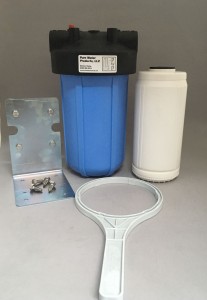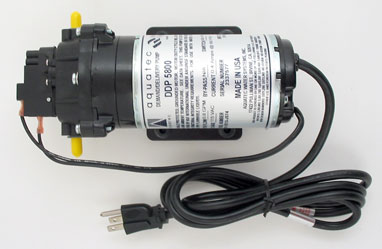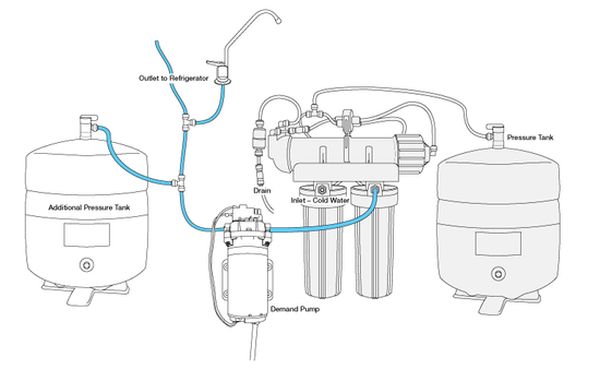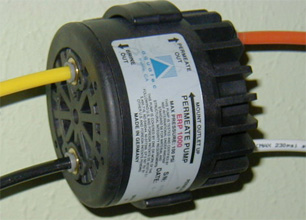Pure Water Occasional, April 30, 2019 |
The water industry acronym NRW stands for "Non-Revenue Water" and that in practical terms means water lost mainly to leaks and misreads from antiquated meters. NRW is water that is processed but not billed to a customer. According to a report from the International Water Association, "The global volume of NRW is estimated at 346 million m³/day (9,100 MGD) . . . . With a conservative value of only 31 cents/m³, that amounts to a $39 billion annual loss." The report concludes that the average water loss across municipal systems in the U.S. tops 20 percent. More.
This "thermal blanket" of shade balls covering a Los Angeles reservoir consisted of 96 million balls and cost $34.5 million.
If you remember, one of the great ideas of the recent past to save water was to cover reservoirs with floating black plastic balls to prevent evaporation. While there were questions raised about plastics leaching into water and providing a fertile growing ground for bacteria, the death blow to the use of shade balls came when someone finally figured out that it takes more water to produce the plastic balls than they could possibly save.
At an Alabama water treatment plant, a chlorine gas-off was caused by the accidential mixing of sodium hypochlorite (bleach) and ferric sulfite, resulting in the release of chlorine gas. Fifty people were sent to the hospital.
Vermont has set a drinking water limit of 20 parts per trillion on combined levels of five PFAS--PFOA, PFOS, PFHxS, PFHpA and PFNA.
The chemical company Chemours revealed that it shipped thousands of pounds of the toxic PFAS subsitute GenX to a plant in New Jersey between 2015 and 2018.
A class-action lawsuit claims that Nestle Waters' Poland Springs brand of bottled water, which advertises itself as 100% natural spring water, is, in fact, a fraud. According to the lawsuit, which runs 325 pages and was filed in Connecticut, none of the water in a Poland Spring bottle could be described as “spring water.” Rather, it is groundwater that has been mislabeled. More: The New York Times.
Fifty years after it caught fire and became the butt of national jokes, the Cuyahoga River has been named “River of the Year” by the conservation group American Rivers. The river's recovery underlines the value and effectiveness of environmental regulation. Regulation works. See the Gazette's story of the Cuyahoga.
Fourteen states and the District of Columbia have joined together to issue a joint statement opposing the Trump administration's push to roll back Obama administration programs designed to protect tributaries and wetlands that shield downstream waters from pollution.
The $14 billion network of levees and floodwalls that was built to protect greater New Orleans after Hurricane Katrina was a seemingly invincible bulwark against flooding. But now, 11 months after the Army Corps of Engineers completed one of the largest public works projects in world history, Scientific American reports that the agency says the system will stop providing adequate protection in as little as four years because of rising sea levels and shrinking levees.
Andersen Air Force Base in Guam has been fined by the Guam EPA for using swimming pool chlorination tablets that are classified as a pesticide to sanitize its drinking water.
Bottled water was the number one packaged beverage in the U.S. in 2018. But a new Consumer Reports investigation finds several brands of bottled water contain arsenic at troubling levels. Details.
The City of Palestine, TX shut down its water service completely after severe storm damage to the city's water treatment plant.
Seawater intrusion—the movement of ocean saltwater into freshwater aquifers—is difficult to combat, partly because traditional methods of monitoring it are cumbersome and expensive. With global warming resulting in higher sea levels and over-pumping of coastal freshwater wells, intrusion now threatens the drinking water sources of a large portion of the population. Scientists at Stanford University have developed a valuable new method of measuring intrusion that will make the job much easier. Details.
Important News about Water for Baking
There are plenty of articles about what kind of water makes the best beer or the best coffee. Here's one about the importance of water in baking and what water is best to use. In case you don't want to read the whole article (which turns out to be an advertisement for a proprietary water filter), here's an excerpt worth noting:
Chlorine is one chemical that will have the more noticeable effect on the dough, particularly on the fermentation activity. Yeast, being a natural microorganism, is chlorine sensitive. Tests have shown that at a level of 10 PPM of chlorine in the water the yeast performance will be negatively affected in a dough system. A high level of chlorine could also affect the function of some flour components like enzymes. A slower enzymes activity will also affect the rheology of the dough as well as the fermentation activity.
Good to know that a chlorine level that will kill your goldfish will also keep your dough from rising. You should not dip water from your swimming pool to make biscuits with. And in case you don't know what rheology is,
Rheology is the study of how materials deform or flow, when a force is applied. ... Bread dough rheology is mainly affected by water absorption. In the baking industry, dough rheology and water absorption is frequently studied by the farinograph and mixograph.
So if you bake bread and don't know how to make a farinograph and mixograph, you should at least have a good carbon filter.
|
Utah City Shuts Off Water After Fluoridation Malfunction
|
Following a fluoride pump malfunction in the water system, residents in Sandy City, UT, were told not to drink their water. Now, local regulators are faced with questions about what went wrong and why locals weren’t notified sooner.
Problems began Feb. 6, when a fluoride pump malfunctioned because of a power outage. It flooded parts of the water system with huge amounts of fluoride — which can cause health problems, plus the acidic fluoride also corroded pipes in some homes to release also-dangerous heavy metals such as lead and copper.
But it wasn’t until the city received complaints about taste hours later that it identified and fixed the problem. Workers handed out flyers in what it thought was the affected area, but did not leave flyers behind if residents weren’t at home. Then, it turned out the problem was much larger than first suspected.
In later days, city officials received complaints of health issues outside the small area — and then realized the malfunction had affected thousands of homes. Eventually, the city did use social media, reverse 911, news media notification and sent ‘all hands on deck’ door-to-door to notify residents.
The drinking water ban was eventually lifted, but Sandy City still has some work to do to appease residents following the debacle. As part of the effort, local volunteers went door-to-door collecting water samples for the city to test.
A very expensive process of testing followed involving 200 samples taken citywide of which all but one came back with fluoride at “safe” levels.
A city-released computer simulation suggested that two zones of the city received the highest levels of fluoride. Actual test information was not available but the fluoride level in those areas “exceeded 10 milligrams per liter.”
The city commissioned an independent investigation and the placed the public utilities director on administrative leave while the investigation is pending.
|
Thales and the Philosophy of Water
|

The early Greek philosopher Thales is best remembered for his system of metaphysics based on the belief that everything originated from water and water was the main ingredient of everything. Many of his views helped lay the foundation of modern science. For example, Thales was the first person to predict a solar eclipse accurately, an accomplishment that impressed Isaac Asimov so much that he called it “the birth of science.”
Thales was a well known figure of his time. He was born around 685 BC. He left no writings, and what we know about him comes mainly from Aristotle.
According to Aristotle, Thales believed water was the origin of all things and the world floated on water.
Thales became wealthy, not by selling water softeners, but by using natural evidence to predict olive harvests and investing accordingly in olive oil futures. His other notable accomplishments included measuring the height of the great pyramid by measuring its shadow and discovering magnetism (which he offered as proof that all objects are alive).
|
Sand Dams Provide Water in Semi-Arid Kenya
|
A community sand dam on the Kaiti River in Eastern Kenya
In semi-arid regions of Kenya a period of heavy rains, which usually comes in December, is followed by months of drought. Kenyans have developed a device called the sand dam to get through the long dry season.
Sand dams are built on seasonal rivers, like the Kaiti in the picture below, to hold water for months after the water in the river itself has disappeared.
The sand dams trap water in the river’s sandy riverbed. The dam holds sand as well as water. In fact, a well constructed sand dam usually holds a reservoir of about 60% sand and 40% water.
To make a dam, a high concrete barrier is constructed across a seasonal river. When it rains, the water carries sand downstream, depositing it up to the level of the barrier. When the rains finish, water remains trapped in the piled-up sand for up to a kilometer upstream of the dam.
In terms of volume, an average sand dam in a relatively wide stream such as the Kaiti River can hold up to 5,000 cubic meters of water, equivalent to 5 million liters (1.3 million gallons). To boost the volume of water stored, several sand dams can be built along one river. In one region where 1,500 sand dams have already been built, it is estimated that the dams can retain as much as 2 billion gallons of water.
To use the water, community members scoop out sand from the river bed to expose it. It can then be pumped out for irrigation or other uses.
Over 3,000 households are now using water from the dams to grow vegetables, tomatoes, drought-resistant legumes, fruit trees such as grafted mangoes and oranges, and other crops.
The sand dams now provide water in places where residents formerly had to walk miles in hope of finding water in a shallow well during the dry season.
The sand dam technology is believed to be indigenous to Kenya, though it is now being used in other areas such as Zimbabwe, Brazil, and Thailand.
The Kenya project, however, is the first time dams have been built in such large numbers (literally thousands) and as permanent structures.
Building of the dams has been a joint project of NGOs and locals. The NGO donates cement to eligible groups and offers technical assistance. The self-help group members then have to collect construction materials such as stones, which are locally available, and offer unskilled manual labor during construction.
Typically, 250 people can build a sand dam in a single day.
|
Siliphos is a milk thistle extract. It is made of 100% food grade materials.
Siliphos prevents scale formation and stops corrosion of pipes. After months of use, it can actually slowly remove existing scale from pipes and appliances.
Siliphos acts as a sequestering agent, coating the inside of pipes and making a thin protective layer on metal surfaces to prevent scaling, corrosion and brown or red water.
Siliphos does not alter the taste of the water. It dissolves slowly into the water and acts by preventing the adhesion of minerals to metallic surfaces.
It can be added as an inexpensive whole house or point of use treatment.
Siliphos spheres can be inserted into the center core of carbon block or sediment filters or dispensed through a separate filter housing installed in the water line. The larger system with separate housing lasts longer and supports higher flow rates.
Unlike a conventional water softener, Siliphos is inexpensive, easy to install, does not use salt or electricity, and does not add sodium to water.
Basic Stand-Alone Siliphos Units from Pure Water Products
| Unit Description |
Home Size |
Cartridge Size |
Unit Price (with one cartridge) |
|
Compact unit with clear housing. Installs on 3/4" pipe. Cartridge holds 100 siliphos spheres.
|
1-2 people |
2.5"x9.75" |
$128.00 |
|
Standard unit with blue housing. Installs on 3/4" or 1" pipe. Cartridge holds 200 siliphos spheres.
|
2-6 people |
4.5"x9.75" |
$178.00 |
|
Large unit with blue housing. Installs on 1" or 1.5" pipe. Cartridge holds 250 siliphos spheres.
|
6+ people |
4.5"x20" |
$268.00 |
All units have replaceable cartridges.
Mid-sized siliphos unit with 4.5" x 9.75" replaceable (or refillable) cartridge filled with 200 siliphos spheres. Cartridge replacement is $89.
|
Benzene Pollution After California Fire
|
Editor’s Note: Much has been written of late about water pollution resulting from fires and firefighting chemicals. The article below details how toxic benzene contamination can be a by-product of firefighting. Although the article doesn’t give much information about treatment, from the residential perspective benzene is removed well by carbon filtration, but the filter should be substantial and the carbon replaced fairly often. Benzene is a point-of-entry issue, because it can be inhaled. For much more about benzene, see Pure Water Annie’s “A Few Things You Should Know about Benzene.” And, by the way, we don’t recommend Darlene Stein’s method of water quality assessment.
The drinking water in Paradise, California, where 85 people died last year in the nation’s worst wildfire in a century, is contaminated with the cancer-causing chemical benzene, officials said.
Officials said they believe the contamination happened after the November firestorm created a toxic combination of gases in burning homes that got sucked into the water pipes as residents and firefighters drew water heavily, the Sacramento Bee newspaper reported Thursday.
Officials say that may explain why benzene, which has been linked to anemia and leukemia, has been found in tests at various spots rather than from one source in Paradise, which was largely destroyed.
The chemical occurs naturally in fire; is part of crude oil, gasoline and cigarette smoke; and is used to make plastics, synthetic fibers and other products, according to the federal Centers for Disease Control.
Melted plastic meters and plastic pipes also may have sent benzene into the system, water officials say.
Paradise Irrigation District officials say they have taken about 500 water samples around town, and they have found benzene 30 percent of the time.
“It is jaw-dropping,” said Dan Newton of the state Water Resources Control Board. “This is such a huge scale. None of us were prepared for this.”
Those who have assessed the problem say the water district may be able to clean pipes to some homes later this year, but it will take two years and up to $300 million before all hillside residents can safely drink, cook or bathe in the water.
About 1,500 of the town’s 27,000 residents are living in the few surviving houses. Water officials have warned them not to drink, cook, bathe or brush their teeth with tap water and to only take quick showers with warm water. Those residents are living on bottled water delivered daily and water tank deliveries.
Norman Stein, 84, drives 15 minutes each week to the water distribution center, loads his trunk with bottles and stacks them in his garage.
He and his wife, Darlene, disagree on the risk posed by their tap water in Paradise. She opened the sink tap to show how clear the water is.
“I could feel an oily substance before. But it’s cleared up now,” she said. “This is good water.”
“Only it’s got benzene in it,” her husband retorted. “I won’t even brush my teeth in that stuff.”
Stein is thinking about buying a purifying system, which some of his friends have done. But water officials have said that they don’t know how well in-home filters protect residents if there is benzene in their taps.
Water experts said what happened in Paradise has been detected only once before — during a deadly fire in Santa Rosa last year. They say California must work to ensure the water is safe in Paradise and learn what could protect drinking water in future wildfires.
“This is really just the beginning here,” said Jackson Webster, a Chico State University professor and environmental engineer specializing in the effects of wildfire on water quality. “The fires in Santa Rosa caught people by surprise. Now, it has happened twice. The bells are ringing.”
|
Demand Pumps: How to use them with residential reverse osmosis units
by Gene Franks
|
|
Demand pumps are versatile tools that can also be used to send water to a car wash location, a fish pond, aquarium, or a hot tub. They are sometimes used to move water from a non-pressurized distiller tank to a sink-mounted spigot. They work anywhere a pump is needed to move water to a point of use. They work with a non-pressurized water source or they can increase the pressure from bladder tanks like RO tanks.
|
When there is a “demand” for water, the pump comes on and supplies it. When the demand is removed, the pump shuts itself off.
When you push a button to fill a water bottle from a supermarket’s water vending machine, the button-push activates a solenoid that opens a closed valve in the water line. When the valve is open, the pump senses a demand for water and comes on. It pumps water through the open line until you release the button, closing the solenoid-controlled valve and shutting off the demand. Closing the valve causes pressure to build in the delivery line and the pump senses the pressure and stays off until there is another demand for water.
In the pump pictured above, the water line is installed in the ports marked by the yellow fitting protectors. The pressure switch is the appendage at the extreme left in the picture. It simply shuts off the pump’s electrical supply when water pressure builds in the water line.
Small demand pumps are usually trouble free operators, but in some installations a pump tank should be added to assure smooth operation. Without a tank to provide constant back pressure for the pump’s pressure switch, a phenomenon called “pump chatter” sometimes occurs. If the pressure drops slightly, the pump has to turn on briefly to renew the pressure when no demand for water has been made. Installation of a pump tank prevents this constant on/off cycling and also provides more water in storage and protects downstream plumbing and appliances from the shock of sudden pressure surges. A pump tank, while not always essential, improves the performance of virtually any demand pump installation.
The illustration below shows a demand pump installation on an undersink reverse osmosis unit designed to send pressurized water to a remote refrigerator or icemaker. This is a good design, but there are other placement options. If the pump is installed in the tube labelled “Outlet to Refrigerator,” the sink-top spigot will get water only from the tank at right and the pump will not turn on to serve the sink-top spigot.
The pressure tank at right is the RO unit’s regular storage tank. The tank at left is an additional “pump tank” added to smooth out the pump’s operation and to provide extra storage. Water in the second tank is available for both the kitchen ledge faucet and the refrigerator. A check valve (one way valve) built into the pump head prevents migration of water back to the RO unit.
|
Does the Permeate Pump Save Water?
by Gene Franks
|
The permeate pump has been a popular accessory for domestic undersink reverse osmosis (RO) units for a number of years. It is a non-electric, water-powered device that works by isolating the RO membrane from back pressure from the storage tank.
Standard undersink RO units produce water into a small pressurized storage tank. As the tank fills, the RO unit has to push against increasing back pressure from the storage tank. The greater the back pressure, the more inefficient the RO unit becomes. Standard undersink RO units that store water in a pressure tank never perform as well as the membrane rating. A 4:1 (four gallons to drain for each gallon of product water) membrane, when used on a standard undersink RO unit, actually performs much less efficiently because of back pressure from the storage tank. In informal tests conducted at Pure Water Products, actual efficiency performance of a standard RO in simulated home usage was around 7:1. The unit performed at 4:1 when the tank was empty but the efficiency got progressively worse as pressure built in the storage tank.
The purpose of the permeate pump is to allow the RO unit to produce water into an almost pressure-free chamber. The pump then pushes the stored water into the pressurized storage tank. Water leaves the RO membrane housing in two streams: the purified water (permeate) and the reject or drain water (brine). The pump uses the energy from the brine to push the permeate into the storage tank.
The pump manufacturer claims the pump will save water and also improve the TDS performance of the RO unit. This is discussed in detail, with manufacturer’s charts, in a 2011 issue of the Pure Water Occasional.
An earlier Pure Water Gazette piece reported an informal test done with a single home RO unit that looked at the question of whether the pump improved TDS rejection performance as claimed by the manufacturer. The test showed no improvement in TDS performance with the pump as compared with the same unit without the pump.
The TDS test was done with a standard Black & White undersink RO unit with the GRO 50/50 water saving membrane. The membrane performance rating is 1:1–one gallon of brine for one gallon of permeate. The same unit, now a year older, was used to test the permeate-to-brine efficiency with and without the permeate pump.
We ran six trials: three with a standard unit without permeate pump and using the regular Payne shutoff valve, and three with an Aquatec ERP 500 permeate pump installed and the same Payne shutoff.
Discussion
Standard RO membranes are set up with a ratio of about 4 (drain) to 1 (permeate). With no tank to push back against, a 24 gpd membrane installed with a 250 ml/m drain line flow restrictor will run about 95 gallons of water to drain while producing 24 gallons of drinking water. This works out to around a 4:1 ratio. The GRO 50/50 membrane used in this test is a 50 gpd membrane, paired with a 150 ml/m brine restrictor, so the theoretical production is 50 gallons of permeate while sending 57 gallons to drain. Essentially a 1:1 ratio. (To convert milliliters per minute to gallons per day, multiply by 0.38.) Significantly, a smaller-than-usual storage tank was used to move things along faster. The tank is about a 7.5″ X 9″ petite version, which the manufacturer calls a “2 gallon” size, but which for practical purposes holds about one gallon.
The trial consisted simply of starting with a full tank, draining the tank to catch and measure the content, then allowing the RO unit to refill the tank while catching the brine for measurement. Three trials each were done with and without the pump.
Results were surprisingly uniform. The table below reports the averages in percent recovery, which means the percentage of the water that goes into the RO unit that comes out as permeate. Keep in mind that a standard 4:1 membrane setup without tank has a percent recovery ratio of about 20%; with a tank in a standard residential setting the percent recovery might be 12%.
The Test with GRO Membrane
| Setup |
Total Permeate in fluid ounces |
Total Brine in fluid ounces |
Recovery Percentage |
|
| GRO Membrane, without pump |
114 (0.89 gal.) |
160 (1.25 gal.) |
41.6% |
|
|
GRO Membrane, with pump
|
120 (1.07 gal.) |
118 (0.92 gal.) |
50.4 % |
|
The conclusion is, then, that the permeate pump does indeed save water, even when running with the stingy GRO membrane. With a conventional 4:1 membrane, the saving is more pronounced. Permeate pump manufacturer Aquatec’s performance chart shows conventional membrane performance with the pump at about 12:1 when the storage tank is 60% full. Our tests show overall performance of conventional units averages about 7:1 under normal stop and go residential use, while the permeate pump unit with the same membrane maintains a consistent 4:1 throughout the fill cycle.
One final note about the GRO 50/50 membrane. Although it would appear from the 41% recovery that it is performing at less than the advertised 50% recovery rate, its performance is really quite remarkable. The 50% setup is the performance you get without a tank (as in a tankless “countertop” RO unit). You should get the essentially same performance with a permeate pump, whose job it is to nullify the back pressure from the storage tank. That is what we got in our test.
Here is a summary of simulated performance figures to put all this in perspective:
| Setup |
|
Approximate Recovery Percentage |
|
Standard membrane in undersink standard RO with tank
|
|
12% |
|
Standard membrane in tankless countertop RO
|
|
20% |
|
Standard membrane in undersink RO with permeate pump
|
|
20% |
| GRO membrane in tankless countertop RO |
|
50%
|
|
GRO membrane in undersink RO without permeate pump
|
|
40% |
|
GRO membrane in undersink RO with permeate pump
|
|
50% |
Adding a permeate pump to a standard RO unit improves its recovery percentage by around 10%. Replacing the standard membrane with a 50/50 GRO membrane increases recovery by about 30%.
|
Places to visit for additional information:
|
Thanks for reading and be sure to check out the next Occasional!
|
|
|
|  | |












